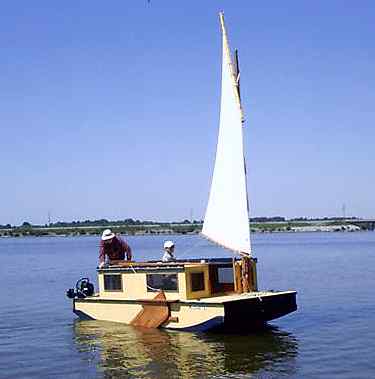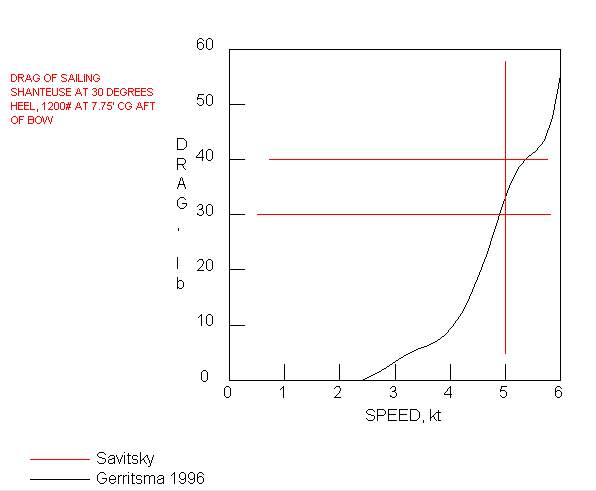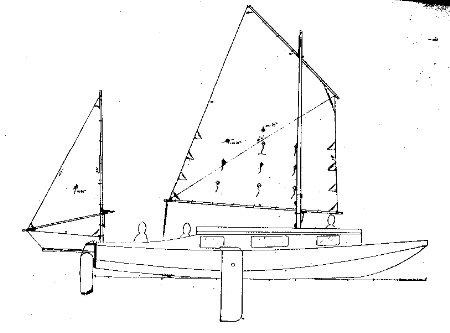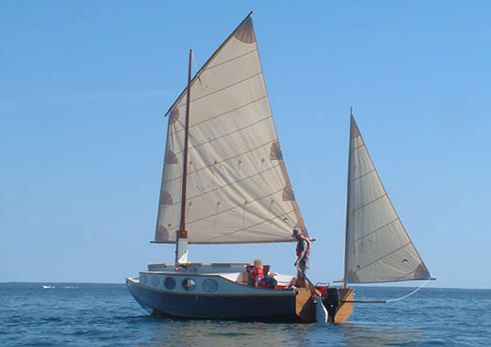
Andy & Caroline Wallis on a short cruise on Lake Huron recently in yet another new Philsboat. Looks great!
Contents:
Contact info:
Jim Michalak
118 E Randall,
Lebanon, IL 62254Send $1 for info on 20 boats.
Jim Michalak's Boat Designs
118 E Randall, Lebanon, IL 62254
A page of boat designs and essays.
(15aug07) This issue will take a second look at that Shanteuse hull shaping thing. The 1 September issue will rerun the taped seam essay.
THE BOOK IS OUT!
BOATBUILDING FOR BEGINNERS (AND BEYOND)
is out now, written by me and edited by Garth Battista of Breakaway Books. You might find it at your bookstore. If not check it out at the....ON LINE CATALOG OF MY PLANS...
...which can now be found at Duckworks Magazine. You order with a shopping cart set up and pay with credit cards or by Paypal. Then Duckworks sends me an email about the order and then I send the plans right from me to you.
Shanteuse Shaping 2
WELL, WHERE WAS I......A couple of issues back I used Hullform to look at the drag of a Shanteuse hull, both the standard squared stern motorboat version, and a swept up stern version like Bob Williams had built for a sailing Shaneuse.
Here is a photos of the blueprint Shanteuse hull as built by Doug Snelson:

And here is the modified hull built by Bob Williams:

The idea behind the swept up stern of the sailing Shanteuse was to reduce drag at sailing speeds. But the Hullform study showed there was about no real difference in drag between the two hulls at slow speeds! Then I got a letter from someone who agreed with my guess that the powered straight tailed version might have lower than expected drag because it has a longer waterline than the sailer and because the draft of the boat is so low at normal weights that the drag of the wide flat transom is not high, it does not have a "deep" transom like many motorboats even though there is no upsweep to its stern. I don't recall the draft of the boat but it clearly would be just 2 or 3 inches. The writer also mentioned that Phil Bolger once proposed a similar test between two real boats made to his Brick design, one with the standard rockered stern hull and another identical but with a straight flat stern run like Shanteuse's. Well, that did it for me. I don't mind being 20 years behind Bolger, he is almost always on the right track about things. I take it that Phil was thinking also that the tiny draft of the flat run Brick plus its longer waterline would make for a boat that sailed with the original Brick but would be much better under power.
FOR A SECOND LOOK....
... I think I will alter the trim of both shapes to see the effect of making the stern draft deeper. Then see if Hullform will show any drag difference during heeling during sailing, another thing that will make for a "deeply immersed transom" in the power boat shape but should make little diff in the swept up sailing hull. I've got to admit I am doing the calculations as I am writing this and have no idea how they will turn out, but that is good science!
LET'S LOOK AT THE EFFECT OF TRIM...
This is easily done with the newer versions of Hullforms since you can make it graph drag/speed curves over a range of cg locations. For the original calcs I put the cg where the boat would float level. Now I will move it aft, immerse the transom deeper and see what happens. For that original powerboat hull I used a weight of 1200 pounds with the cg 9.8' aft of the bow to get level trim with 3.5" of draft. I varied the cg from 10 to 13' (pretty extreme for a 16' boat) and got this:

Clearly trim has little effect until about 3.5 knots. Then the drag goes very high for the trim with a deep stern, about 10" deep for the cg=13 case. I can tell you that the bow of that boat is very much high in the air at that trim and looks like a rocket on takeoff. It is highly unlikely that anyone would load a boat that way and expect to get anywhere.
Now let's use the same cg variation on the swept up sailing Shanteuse. With this boat level trim was achieved at cg=7.75' which resulted in a draft of 4.4". In the test I varied the cg from 8" to 11' and got these results:

Now these is a difference. The sailing hull with cg at 11' has its transom just kissing the water, it is a very extreme trim but the transom is not immersed and the graphs show there is little effect in trim, something you would hope for with such a boat.

For the power hull it appears that at 5 knots the drag hovers around 60 pounds or so as long as the trim is not too extreme. For the most extreme trim shown drag jumps to say 340 pounds at 5 knots but I doubt if any serious boater would operate his craft that way.
For the sailing hull the drag at 5 knots varies from about 70 pounds to 110 pounds. At exteme trim the max value looks to be a lot less than that of the power hull, really about a third as much. So the sweep of that sailing stern helps in extreme trim situations but not in normal trim! Pretty much what we learned a month ago. One must remember that the advantage of the swept hull is probably no real advantage since it happens at an extreme trim that only a land lubber would accept.
LET'S LOOK AT HEELING DRAG...
It occurred to me that Hullform might calculate drag of a hull that is heeled in sailing. Let's see if it will. Here is the drag prediction of the sailing hull with zero heel angle:

Drag looks to be about 60 pounds at 5 knots. Now let's look at 30 degrees heel:

WOW! I wasn't expecting that. Hull drag at 30 degrees heel is about half that of upright. It is well known that some hulls sail best when heeled but this is quite a change. Is Hullform doing this correctly? I have no idea how the drag is calculated but I know the times I have tried to measure the drag of a real hull the results agreed with the Hullform prediction. Now, there might be another problem - trying to really sail the Shanteuse at 30 degrees heel might be a bit of work. But clearly if you have a hull like this you should look into keeping it heeled when sailing.
Now we will try the same curves with the straight sterned power hull. With no heel we get this drag/speed curve:

Drag at 5 knots appears to be about 60 pounds, less than the sailing hull with no drag. But the curve at that point seems to waver a lot, a hump and a dip, and when I did drag tests on AF4 a while back these humps and dips never could be seen in the tests, the results were a smooth curve. Now the same boat at 30 degrees heel:

I was afraid of that. Only about 16 pounds drag at 5 knots, less again than the sailing hull. Well, I don't believe it. What else can I say. Still best to present this stuff even though I can't expain it. Must not forget that Hullform drag predictions have proven good in the past although I never tried the heeled drags.
Well, Bolger is right again - you have to build two real hulls and test. Then I'll believe it. One last comment is that I would expect the handling of the sailing hull to be superior to the power hull if these were both to be sailed.
NEXT TIME...
...We'll rerun the taped seam essay.
Cormorant

CORMORANT, CABIN SAILBOAT, 32' X 8', 2500 POUNDS EMPTY
Cormorant is the largest boat I've ever designed. I always warn folks to think twice and three times before building a big boat because you can buy a good used glass boat for less, maybe a lot less. But a homebuilt boat can have features that aren't available in a production boat and so it is with Cormorant. This one is really a 20% enlargement of Caprice.
Straight enlargements rarely work perfectly and so it was with Cormarant from Caprice. (Don't forget that Caprice was an enlargement of Frolic2, etc., etc., right on down to my Toto canoe.) In this case I narrowed it from a straight enlargement to keep the width within simple towing limits since this large boat is supposed to live on its trailer most of the time. The layout is quite similar. The idea is that the adults sleep in the center cabin and the kids sleep in the forward room.

Like Caprice, Cormorant has water ballast, over 1000 pounds of it. Total floating weight with family is going to be up to 4500 pounds. You don't tow a boat this large behind a compact car but I think towing this sort of weight is common today, all done with expensive large trucks I'm afraid.
The sail rig looks pretty modest with a 207 sq foot main. I'll bet it is enought since this shape is easily driven. I don't think you can go any larger and still hope to handle it without extra crew and gear.Tthe lug sail shown is similar in size to Bolger sharpies and they seem to get by OK. Experience will show if it is too big/too little.
Constuction is taped seam, with no jigs or lofting. Unlike smaller designs this one does not come with a plywood panel layout drawing. Over the years I've learned two things about the ply layout page. First is that almost no one uses it. Second is that with a larger boat the work of finding and drawing and fitting all the pieces to the boat on scale plywood sheets overwhelms all the other work. So part of the deal with doing the design was that there would be no plywood layout drawing. However this is still a true "instant boat" in that all of the parts that define the boat are drawn in detail and you can scale them up on plywood, cut it out and fasten together with no need for lofting or a building form.
Garth Battista, who is a book publisher at Breakaway Books where he publishes sporting books including my Boatbuilding For Beginners (And Beyond), is a true boat nut and has worked himself up from dinghies and canoes to the big Cormorant. He took it initially on a quick shakedown run on a lake near his home and shortly later to Long Island Sound for a week with his family. Here are his comments:

"We had an amazing time living aboard Cormorant (christened "Sea Fever") in Provincetown harbor for 5 days. The tide there was rising and falling about 12 feet a day with the full moon. We'd be high and dry up on the beach for breakfast, swimming off the boat at lunchtime, walking the flats again by dinner. It was a blissful time for me and my wife and two girls. We moved around, took little sails here and there across the harbor (West End to Long Point, then to the lighthouse, then to the East End, etc.) anchoring here and there, usually just running it aground as the tide allowed and staying for a while. Many shells were collected, and tidal pools investigated. Of all the harbors I've ever seen, it is the most alive. It's a couple of miles across and fresh sea water flushes the whole place twice a day. The number of snails, clams, crabs, fish of all sizes, mussels, eelgrass, etc. was just mind-boggling. On high tides I'd go spearfishing (many attempts, no luck) where at low tide I'd been walking around.

We rigged a 8' x 15' white tarp with tent poles running crosswise as a canopy over our cockpit and hatch, supported along the mast folded down in the tabernacle, so we could escape the mid-day sun. Most days were hot and humid and mild, with only gentle winds. We rode out a nighttime thunderstorm with no trouble, just stayed up and watched the lightning. We attended a few wedding-related events, just walking ashore for one party, and for the wedding itself we returned late at night and rowed our dinghy out to the boat, our sleepy children just awake enough to get themselves aboard.

For our last two days we gave up the shallow-water life and sailed from P-town down to Wellfleet, about 7 miles, surfing along on gentle 3-foot waves with a following wind. We beached the boat at Great Island, walked the beach, had a picnic dinner, swam and played, spent the night, and left the next morning at 6 a.m. to beat the falling tide. Our weather radio mysteriously quit working that morning, so all we had was the prior day's forecast of 10-15 knot winds from the SW.

The wind had shifted into the west during the night, so we had to beat out of the harbor, and once we turned north to return to Provincetown, huge rollers were coming in off the bay, more or less directly into our port side, lifting us, rolling us, occasionally breaking and spraying water into the boat. We stayed well offshore to avoid the breakers in by the beach -- but with the falling tide it seemed that we needed to be nearly a mile out. It went from exhilarating to worrisome to mildly terrifying as we neared P-town and the wind kept picking up, past 20 knots to 25 and higher in gusts, and the waves just kept growing. The swells were in the 8-10 foot range, with a high percentage of them breaking at their tops, whitecaps everywhere.

But bless this boat! With its 1000 lbs. of water ballast, and the leeboard mostly up, we were able to bob and roll and slide over nearly all the swells. The worst of them were very steep and threw us sideways, maybe tilting us to 40 or 45 degrees briefly. We had two reefs in the main and the mizzen rolled down to about half-size, and still we blasted along on this nasty rollercoaster of a beam reach. It was the sort of trip that would be scary fun if it was just you and a buddy, but it's awful when you have your loved ones aboard, and you wonder who might get thrown overboard, and how you'd managed a rescue in the rough conditions.

Anyway -- the white knuckles got to relax as we finally made it past the P-town breakwater, and with great relief ran her aground out on the flats. The gale (or near-gale) continued to blow all day, kicking up 3 and 4-foot waves even in the protected areas of the harbor. The only boats we saw going out were an 80-foot schooner and a big whale-watch boat. A lobsterman we talked to later said he'd stayed in as it was too rough to check his traps.
We had a hell of a time taking the boat out and getting her on her trailer for the trip home -- but all worked out in the end, with the assistance of some very kind strangers; and I'm left with the memories of incredibly happy days. -- And an incredible boat.

All best, Garth
P.S. Jim -- I should also mention that on Sunday afternoon as we turned the corner from our run down to Wellfleet to the close reach upwind toward the inner harbor, the boat just drove perfectly. It seemed we made 40 degrees off the wind. That maybe wishful thinking, but it was an angle far better than I'd imagined a lugsail could manage. It was a joy to sail, in all conditions. My hat is off to you.
P.P.S. The number of people who came over to admire the boat and exclaim at its uniqueness, its coolness, its obvious functionality -- well, they were beyond count. "
Plans for Cormorant are $60 when ordered directly from me.
Prototype News
Some of you may know that in addition to the one buck catalog which now contains 20 "done" boats, I offer another catalog of 20 unbuilt prototypes. The buck catalog has on its last page a list and brief description of the boats currently in the Catalog of Prototypes. That catalog also contains some articles that I wrote for Messing About In Boats and Boatbuilder magazines. The Catalog of Prototypes costs $3. The both together amount to 50 pages for $4, an offer you may have seen in Woodenboat ads. Payment must be in US funds. The banks here won't accept anything else. (I've got a little stash of foreign currency that I can admire but not spend.) I'm way too small for credit cards.
I think David Hahn's Out West Picara is the winner of the Picara race. Shown here on its first sail except there was no wind. Hopefully more later. (Not sure if a polytarp sail is suitable for a boat this heavy.

Here is a Musicbox2 I heard about through the grapevine.

HOLY COW! A Jukebox2 takes shape in Minnesota. Unheated shop means no work during the winter. Check out that building rig! (Wait a minute! I just got a CD of photos of a Jukebox2 finished in the Sydney, Australia area by Ted Arkey!)

And the Vole in New York is Garth Batista's of www.breakawaybooks.com, printer of my book and Max's book and many other fine sports books. Boat is done, shown here off Cape Cod with mothership Cormorant in background, Garth's girls are one year older. Beautiful job!

AN INDEX OF PAST ISSUES
Hullforms Download (archived copy)
Plyboats Demo Download (archived copy)
Brokeboats (archived copy)
Brian builds Roar2 (archived copy)
Herb builds AF3 (archived copy)
Herb builds RB42 (archived copy)